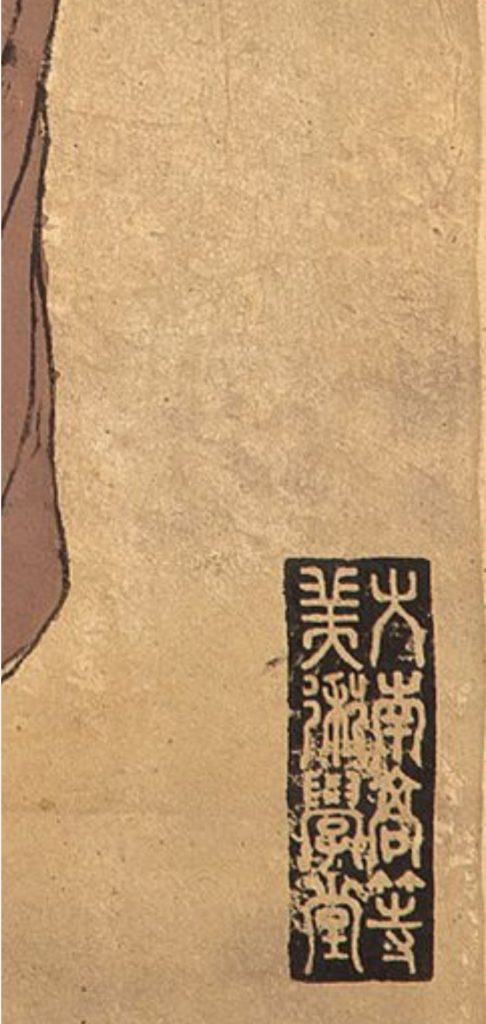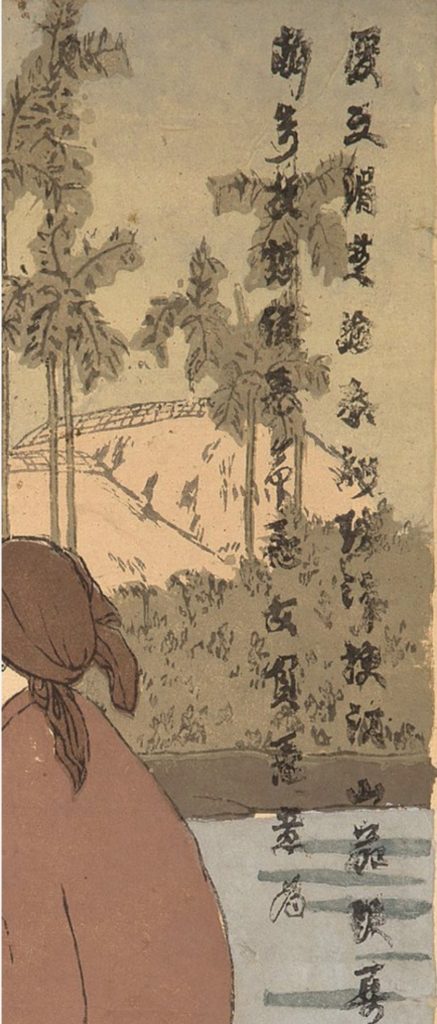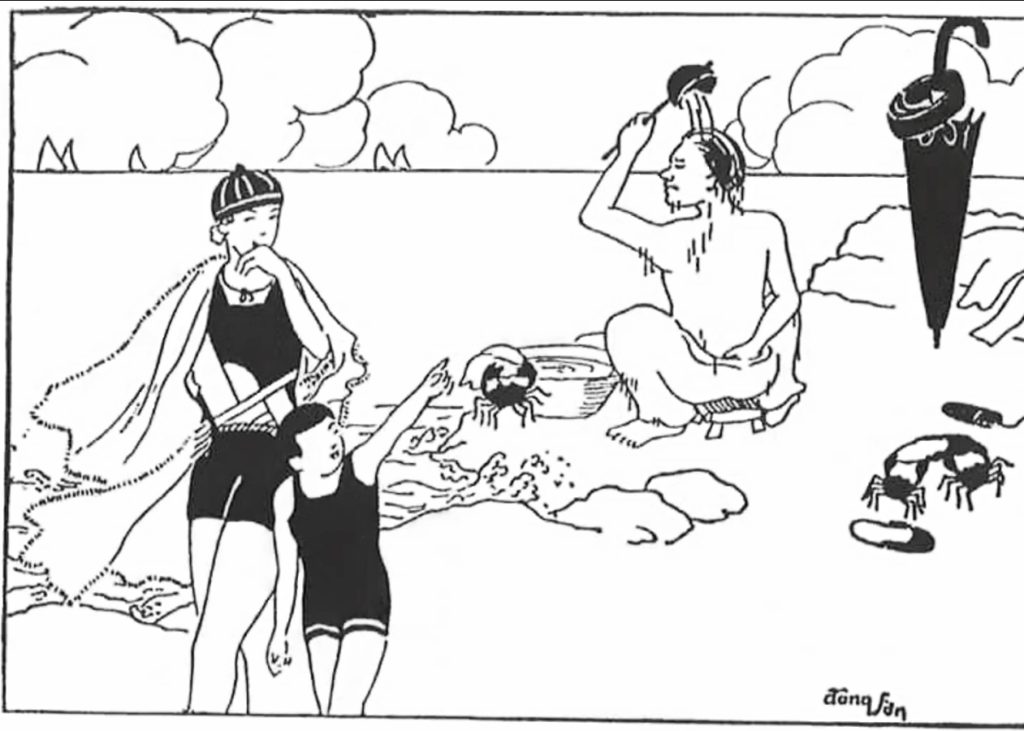Nguyễn Tường Tam (1906-1963), circa 1926, or, “why bother with so rains and tan clouds?”
The scene is all déjà-vu: a young woman with a child in her arms. A woman with a walking stick. Traditional clothing for both. The three of them engaged in conversation.
In the background: river, trees, houses: a setting more than a landscape. The dull colors of the work reinforce the gloominess of the subject.

The print is by Nguyễn Tường Tam. It is undated but, given the biographical elements, develop below, it was probably created around the year 1926.
We don’t and we will never know how many copies of this large work (72 x 45 cms) were “published”.
The rectangular seal in Chinese characters, lower right, reads:

大南高等美術學堂 : « École des Beaux-Arts de l’Indochine »
The two vertical columns of ideograms define the scene.
We know that Vietnamese poetry, with its subtle prosody, also cultivates metrics.
Two columns of verse in chữ nôm in a very specific Vietnamese form called “lục bát”, with a 6-foot verse followed by an 8-foot verse, bear witness to this. For reference, Lê Thành Khôi, in his magnificent “Aigrettes sur la rizière” (Paris, 1995), best explains the finer points (pp 14-15).

The nun addresses the young woman:
“Why worry about the rains of Sở and the clouds of Tần?
A woman, when married, carries her husband’s homeland on her shoulders.
For a hundred years, keep the word “loyalty” intact,
What heart would dare betray such devotion?”
Direct and moralistic, the address nevertheless charms with its use of the terms “rains of Sở” and “clouds of Tần” (雲雨 / 云雨 Yúnyǔ).
All in nuance, these evoke the carnal relationship between a woman and a man.
Nguyen Dû in the Kim-Van-Kieû makes use of this (chapter 3 (“Le brasier ardent”) of the second part, evoking Kieû (in the Gallimard-Unesco translation by Xuân-Phuc and Xuân-Viêt, Paris, 1987 p. 90):
“Poor face tanned by the wind, cracked by the dew! Poor body, worn out by bees and butterflies! Let others devote themselves to the rains of So, the clouds of Tân!” (Verses 1236-1239 p. 90).
Kieû herself, stating earlier:
“I’m here to welcome wind and rain” (verse 1202 p. 89)
The expression is very old, since it comes from a poem by the Chinese Song Yu (~332–284, or ~298-~222) known by the Vietnamese as Tống Ngọc 宋玉 .
In Song Yu 宋玉 and the birth of erotic poetry in China, Rémi Mathieu (Études chinoises. 漢學研究 Année 2017 36-2 pp. 17-44) sheds light on the best-known of the Song Yu’s rhapsodic poems, the Gaotang fu 高唐賦) (“Rhapsody of the Gaotang”) in which the poet recounts the amorous encounter at the so-called Gaotang pavilion between the Chu king of olden times and “a goddess who seems to be the one from Shaman mountain, Wu shan. After meticulously describing Mount Wu, its landscapes, flora and fauna, immortals and magicians, the poet invites the Prince of Chu to visit the site following a purification. But the piece’s greatest interest lies in a short passage in which the goddess appears to this king in a dream and aspires to offer him “the pillow and the mat”, thanks to which the sovereign could “honor her”. This is one of the rare cases of explicit erotic union in which, moreover, it is the woman who proposes and obtains it.“
The appearance here of clouds and rain, in the morning and evening, gave rise to the expression “clouds and rain”, a well-known metaphor for sexual intercourse.
Our print therefore appears to be steeped in Buddhism and Confucianism, and firmly rooted in Chinese tradition. Too many references, perhaps, leading to the acceptance of a fixed world?
Probably quickly alerted to this, Nguyễn Tường Tam became the illustrator of his own political ideas.
The “caricature” below, signed by one of his aliases Đông Sơn, bears witness to this.
Published in the Phong hoà of July 24, 1933, captioned in Vietnamese “A scholar at the beach”, it already brings together many of the themes that Nguyễn Tường Tam would defend within the Tự-Lực văn-đoàn, of of which he would be one of the founders in 1934.
To describe this Ly Toet emulator, he once again demonstrated a firm line and lively construction. The result is sympathetic, but nothing transcendent. The concision is a little dry, the line more witty than aesthetic.

Our print and this cartoon (among others) show that Nguyễn Tường Tam cannot therefore be recognized, despite his initial vocation (he entered the School in the first graduating class in 1925 and stayed for two years), as an artist of the Hanoi School of Fine Arts. Admittedly, the Hanoi School of Fine Arts was not intended to train recognized artists. For further proof, we need only refer to article 1 of its founding decree (of which there are 17). Signed on October 27, 1924, by Governor General Merlin, it states:
“A “École des Beaux-arts de l’Indochine” is created in Hanoi for higher education in the arts, drawing. Drawing teachers for the Etablissements d’Enseignement complémentaire and Écoles professionnelles d’Arts décoratifs will be recruited from among the students graduating from this school”.
And so the verdict, cruel if not petty, falls: Nguyễn Tường Tam is not a great artist, but a likable illustrator.
Better still, he’s going to illustrate himself. He will be the medium.
Three works in French mention him in different genres, complemented by a Wikipedia page:
- Maurice M. Durand and Nguyen Tran-Huan, Introduction à la littérature vietnamienne, Paris, 1969 focus on the writer, known under the alias Nhât Linh.
- Nguyên Van Ky (with… Georges Boudarel) Hanoi 1936-1996 Du drapeau rouge au billet vert Paris, 1997 provides a concise biography.
- François Guillemot Dai Viet indépendance et révolution au Vietnam L’échec de la troisième voie (1938-1955) Paris, 2012 offers a comprehensive overview of his political struggle and the issues at stake in the years concerned. The well-documented Wikipedia page completes the 3 approaches.
We have reproduced many elements of these three works here.
For more details, the first and third works have an index.
Nguyễn Tường Tam (1906-1963) was born on July 25, 1906 near Hanoi into a family declining in social status generation after generation, from a grandfather who was Minister of the Armies under Emperor Gia Long (1762-1820) to a father who was a modest secretary in a provincial colonial administration.
He learned Chinese ideography, then attended the “Lycée du Protectorat” (better known as the “Lycée des Pamplemousses”) in Hanoi. In 1924, he joined the Finance Department. He met Hô Trong Hiêu, the satirical poet (later known by the pseudonym Tu Mo).
The same year, he entered the Indochinese University, initially in medicine, before abandoning it for the School of Fine Arts, where he was admitted with honors in 1925, in the first class that included Le Pho, Mai Thu, Lé Van Dé, Nguyen Phan Chanh, Công Van Chung and Lê Ang Phan… He dropped out (like Lê Ang Phan) in his 2nd year, and never graduated.
He migrated to Saigon and then Laos, where he became a designer for film posters.
He married and moved to France in 1927, enrolling at the Toulouse Faculty of Science from which he graduated two years later. Imbued with the French way of life, where everything is a pretext for protest, he developed a passion for democratic debate. He was fascinated and stimulated by the ironic satire of Le Canard enchaîné.
After 3 years in France, he returned to Vietnam in 1930, where he taught at the Thang Long private school in Hanoi. There, he rubbed shoulders with fellow teachers such as the Marxist Dang Thai Mai, Hoang Minh Giam, future leader of the Viêt-minh in 1945, Tôn Thât Binh, and Vo Nguyên Giap, who needs no introduction.
To promote his progressive ideas, Nguyễn Tường Tam worked with his brothers and friends on a project for a Vietnamese-language newspaper called Tiếng cười (The Laugh). However, as authorization was slow in coming, he obtained the management of a title threatened with bankruptcy, Phong Hóa (Morals). Completely revamped, with the help of his brother Hoang-Dao, Tu Mo, Thé Lu and Khài-Hung, the paper appeared in July 1932 and claimed to be the first satirical newspaper illustrated with caricatures.
The 1930 uprisings led by the nationalists, notably in Yen Bay, and the formation of the Nghê Tinh soviets orchestrated by the communists were harshly repressed, and Phong Hóa cautiously reserved his criticism for Vietnamese collaborators with the colonial power, as he was unable to destabilize the latter. He also proposed the foundations of a modern society. In May 1935, after a very large print run of 10,500 copies, it ceased publication for good after four years.
Since 1934, he and his friends had published another newspaper, Ngày Nay (today), with the same content, in anticipation of Phong Hóa’s closure.
Together, they founded the (Autonomous Literary Group). The only independent publishing house, Editions đời này (Our Time), the group enabled the publication of a large number of novels and short stories. Durand and Nguyen point out (pp121-122) that “like Khái Hung, (his) novels were incredibly successful everywhere, both in the South and the North”.
Then the Second World War broke out, he played a role in founding the nationalist-inspired Dai Viêt party.
In 1941, pursued by the Vietminh, he joined the survivors of the Viêt Nam Quôc Dan Dang, who retreated to China. When the Vietminh took power in September 1945, following Japan’s surrender, he returned home to reinforce the nationalist ranks and… to fight his real enemy (since French colonial power had been eradicated by the Japanese coup of March 9, 1945): the Vietminh.
The Vietminh quickly carried out a massive “purge” that decimated the nationalist ranks.
Confusion abounds.
All the Vietnamese nationalist factions competed, intrigued, negotiated and killed each other in turn with the Vietminh. The ultimate goal was to be represented in the new government that was forming.
Meanwhile, the Chinese Nationalist army of General Lu Han (himself a member of the Kuomintang…) was entrusted by the Allies (under the Potsdam Accords – July 17-August 2, 1945) with the administration of North Vietnam, with the British in charge of the South (the zones of influence being delimited by the 16th parallel).
The revolution of August 1945, the declaration of independence on September 2 and the elections of January 1946 led to a new coalition government, with Nguyên Tuong Tam as Foreign Minister. He led the Vietnamese delegation to the Dalat conference in April-May of the same year, without much success.
Ho Chi Minh and his comrades in arms grew stronger, and under Giap’s aegis began the total liquidation of the nationalist camp.
He then fled to China, while trying to organize the nationalist front. He returned to Vietnam in 1951 (along with one of his fellow travelers, Nguyen Gia Tri), residing in Dalat. In 1956, he returned to Saigon, where he set up new magazines and publishing houses, and continued to write novels. In 1960, he launched the political movement Mat trân quôc dân (National Solidarity Front), opposing the dictatorship of Ngo Dinh Diêm (who was assassinated on November 2, 1963) and his family.
His trilogy “Le cours du fleuve Thanh Thuy“, published in 1961, met with great success. But he was a troublemaker: accused of subversive activities, he was summoned to court for July 8, 1963. The day before, after reuniting with his family and seeing his friends again, he finally committed suicide, leaving these powerful words:
“History will judge my life. I can’t bear to be judged by anyone. Arresting and sentencing the national opposition is a grave mistake and will lead our country into the hands of the communists. In this way, I will self-destroy like the venerable Thich Quang Duc who set himself on fire as a warning to all those who trample on freedoms”
(Đời tôi để lịch sử xử. Tôi không chịu để ai xử tôi cả. Sự bắt bớ và xử tội những phần tử quốc gia đối lập là một tội nặng, sẽ làm cho nước mất về tay Cộng sản. Vì thế tôi tự hủy mình cũng như Hòa Thượng Thích Quảng Đức đã tự thiêu là để cảnh cáo những ai chà đạp mọi thứ tự do).
It’s not indifferent that a man of such honesty, dedication, and honor believed at the age of 18, when the School of Fine Arts was being established in Hanoi, that it could accommodate his passions.
Nguyễn Tường Tam did not become an artist, but rather pursued a passionate quest for a political project and the construction of a literary work.
He was neither Le Pho, nor Ho Chi Minh, nor Dương Thu Hương, but like so many others, a fallen actor in his own destiny.
The good nun’s admonition was like a hymn to him:
“For a hundred years, keep the word ‘loyalty’ intact,
What heart would dare betray such devotion?“
Until the end of despair.
Jean-François Hubert